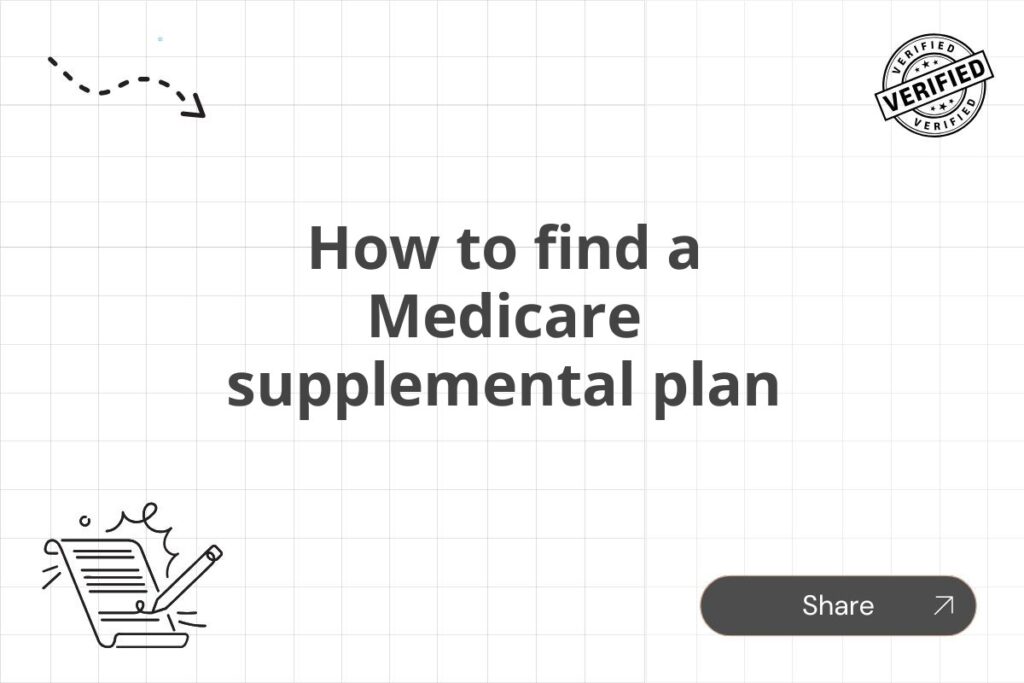Meta Description: Navigating Medicare supplemental plans can be confusing. This comprehensive guide helps you understand your options, compare plans, and find the best Medigap policy to fit your needs and budget. Learn how to choose the right coverage and avoid costly mistakes.
Finding the right Medicare supplemental plan, often called Medigap, can feel like navigating a maze. With numerous plans offered by various insurance companies, each with its own coverage details and premiums, the process can be overwhelming. However, with a systematic approach and a clear understanding of your needs, you can successfully find a Medigap policy that provides the ideal level of coverage and fits your budget. This comprehensive guide will walk you through the entire process, ensuring you’re well-equipped to make informed decisions.
Understanding Medicare and Medigap
Before diving into the specifics of finding a Medicare supplemental plan, it’s crucial to understand the basics of Medicare itself. Medicare is a federal health insurance program for people age 65 or older, certain younger people with disabilities, and people with End-Stage Renal Disease (ESRD). It consists of four parts:
- Part A: Hospital insurance, covering inpatient care in hospitals, skilled nursing facilities, hospice, and some home healthcare.
- Part B: Medical insurance, covering doctor visits, outpatient care, some preventive services, and durable medical equipment.
- Part C: Medicare Advantage, an alternative to Original Medicare (Parts A and B), offered by private insurance companies. It often includes Part D prescription drug coverage.
- Part D: Prescription drug insurance, helping to cover the costs of prescription medications.
Medigap plans, or Medicare Supplement Insurance, are sold by private insurance companies to help fill the gaps in Original Medicare’s coverage (Parts A and B). They help pay for some of the out-of-pocket costs that Original Medicare doesn’t cover, such as deductibles, copayments, and coinsurance.
Choosing the Right Medigap Plan
There are ten standardized Medigap plans, labeled A through N. Each plan offers a different combination of coverage. The plans are standardized, meaning that Plan G offered by one insurance company will offer the same coverage as Plan G offered by another company. However, premiums can vary significantly.
Factors to Consider When Choosing a Plan:
- Your Health Needs: Consider your current health status and potential future health needs. If you anticipate significant healthcare expenses, a plan with more comprehensive coverage might be worthwhile, even if it costs more.
- Your Budget: Medigap premiums vary widely depending on the plan and the insurance company. Balance the level of coverage with your ability to afford the premiums.
- Your Doctor Network: While Medigap plans don’t have networks in the same way Medicare Advantage plans do, it’s helpful to check if your preferred doctors are accepting Medicare.
- Your Financial Resources: Consider how much you can comfortably afford in out-of-pocket expenses, even with a Medigap plan. A plan with lower premiums may require you to pay more out-of-pocket.
- Future Needs: Think about your long-term healthcare needs. A plan with broader coverage might be a better investment in the long run, even if the upfront cost is higher.
How to Find a Medicare Supplemental Plan
Finding the right Medigap plan involves several steps:
Step 1: Determine Your Eligibility
Ensure you are eligible for Medicare before applying for a Medigap plan. You’ll generally need to be 65 or older or qualify for Medicare due to disability or End-Stage Renal Disease (ESRD).
Step 2: Compare Plans
Use online comparison tools, such as Medicare.gov or private comparison websites, to compare plans offered by various insurance companies in your area. Pay close attention to the coverage details and premiums for each plan. Don’t just focus on the lowest premium; carefully consider the value of the coverage provided.
Step 3: Review the Plan Documents Carefully
Before enrolling in any plan, thoroughly review the policy documents to understand the coverage details, exclusions, and any limitations. Don’t hesitate to contact the insurance company directly if you have any questions or need clarification on specific aspects of the plan.
Step 4: Contact Insurance Companies Directly
Once you’ve narrowed down your options, contact the insurance companies directly to discuss your specific needs and get personalized quotes. They can answer any remaining questions you might have about the plans and the enrollment process.
Step 5: Review Your Medicare Summary Notice (MSN)
After enrolling in a Medigap plan, review your Medicare Summary Notice (MSN) carefully to make sure the claims are being processed correctly and that your plan is covering what you expect.
Step 6: Consider Your Open Enrollment Period
You have a six-month period when you first become eligible for Medicare to purchase Medigap without the insurance company being able to deny you coverage or charge you more based on your health status. This is called your Medigap Open Enrollment Period. You only get this opportunity once. Missing it will mean that insurance companies will have more ability to deny you coverage or charge you more.
Tips for Avoiding Costly Mistakes
- Avoid high-pressure sales tactics: Be wary of insurance agents who use high-pressure sales tactics. Take your time, research your options, and make an informed decision.
- Don’t rely solely on price: The cheapest plan isn’t always the best. Consider the value of the coverage you’re receiving compared to the premium.
- Read the fine print: Always read the policy documents carefully to understand the coverage details, exclusions, and limitations.
- Compare apples to apples: When comparing plans, ensure you’re comparing plans with similar coverage levels. Don’t compare a Plan G to a Plan A without fully understanding the differences in coverage.
- Consider your long-term needs: Your healthcare needs may change over time. Choose a plan that will adequately address your future needs.
- Ask questions: Don’t hesitate to ask insurance agents or company representatives any questions you may have.
Where to Find More Information
For more information about Medicare and Medigap plans, you can consult the following resources:
- Medicare.gov: The official website for Medicare, providing comprehensive information on Medicare and Medigap plans.
- State Health Insurance Assistance Programs (SHIPs): These programs offer free, unbiased counseling to help you understand your Medicare options.
- Your local Area Agency on Aging: These agencies can provide information and assistance with Medicare enrollment and other senior services.
Finding the right Medicare supplemental plan is a crucial step in securing your financial and health well-being in retirement. By following the steps outlined in this guide and taking the time to carefully consider your individual needs and budget, you can confidently choose a Medigap policy that will protect you against high healthcare costs in the years to come.






















